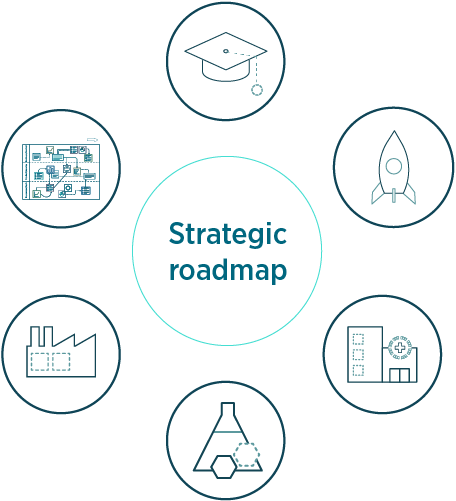Why a strategic
roadmap is important
Roadmapping
IfM approach
Consultancy
Courses
Case studies
Resources
Roadmapping
IfM approach
Consultancy
Courses
Case studies
Resources
Strategic roadmaps play a vital part in delivering strategy and innovation in many organisations across a range of sectors. This page gives an overview of this powerful strategic sense-making tool and highlights many reasons why it should be of interest to anyone interested in strategy, business planning and innovation management.
Strategic roadmaps play a vital part in delivering strategy and innovation in many organsiations across a range of sectors. This page gives an overview of this powerful strategic sense-making tool and highlights many reasons why it should be of interest to anyone interested in strategy, business planning and innovation management.
WHAT IS A STRATEGIC ROADMAP
A strategic roadmap is a structured forward-looking diagram that sets out an integrated view of the way forward for an organisation, sector or other system. Roadmaps represent the pathway/s towards value, from the current position to future aspiration, along with enablers and barriers along the way.
For industrial applications, roadmaps typically combine commercial and technical perspectives, ensuring that customer needs and technical solutions are considered in tandem. A roadmap is not a static forecast, but rather a device to support strategic navigation, updated periodically as events unfold and new knowledge is gained.
Although the most common visual format looks similar to project and programme plans, roadmaps have greater scope and longer time horizon, providing context and direction for strategic decisions, plans and budgets. This format is useful for developing and deploying strategy, providing the basis for developing simpler roadmaps to support wider communication of strategy.
WHY SHOULD YOU USE A STRATEGIC ROADMAP?
Roadmapping is a very flexible approach and can be applied to virtually any strategic context or need, adapted appropriately. Identifying the purpose of the roadmap is vital to ensure the approach is focused and configured appropriately in terms of structure, format and process.
Organisations often consider roadmapping motivated by a need to develop strategic plans in response to opportunities or threats, yet some of the early benefits often relate to diagnostics and problem-solving. Roadmaps can quickly pull together knowledge from across an organisation to establish the big picture, identifying what is known and not known to build consensus on outputs, as well as strategic decisions and actions moving forward.
There are many reasons why organisations look to develop roadmaps, but some of the most common include:
- Adapting to changes in the market, such as responding to competitive action or exploring opportunities for new disruptive technologies;
- Planning complex transformation projects in areas such as digital transformation and supply chain reconfiguration;
- Aligning multiple organisations at the start of collaborative projects focusing on resources, objectives and strategy;
- Capturing a comprehensive and clear overview of technology, market and competitor intelligence;
- Aligning technology and product direction, so organisations have the right capabilities in place to effectively capture value; and
- Enhancing an organisation’s innovation pipeline by effectively linking customer needs with new product and service development.
Through focusing on addressing pain points ensures quick wins, demonstrating value from the approach, and providing the basis for longer-term gains relating to improved alignment, integration, and synchronisation of activities in the organisation.
WHAT CHALLENGES CAN YOU CREATE A STRATEGIC ROADMAP FOR?
The six fundamental questions associated with the roadmap structure (why, what, how, when, who and where) are universal. That’s why roadmapping is an extremely flexible technique, and the systems thinking behind the method can be applied to any system. This always involves some experimentation and customisation of roadmap structure, format and process.
An internet search for roadmaps in virtually any sector, application or technology will demonstrate this flexibility, and this is supported by examination of the associated literature. Applications ranging from personal career roadmaps to coordination of entire sectors (such as semiconductors) have been observed.

FIND THE RIGHT APPROACH FOR YOUR CHALLENGE
Strategic roadmapping
For creating business unit, corporate, sector or policy roadmaps.
Technology roadmapping
For creating product, service and technology roadmaps.
WHAT ELEMENTS OF THE ROADMAPPING PROCESS CONTRIBUTE TO CREATING A SUCCESSFUL STRATEGY/PLAN?
Sometimes there is confusion as to where the boundaries between roadmapping and strategy are, as roadmaps provide visual expression of strategies and plans. It is sensible to think of roadmapping as primarily a service to other core business processes, such as strategy and innovation. Thus, roadmapping focuses on the appropriate structured visual representation of strategy, so that it can be explored, adjusted and effectively communicated.
When considered in this way, the key question becomes: what does a successful strategy/plan look like? The answer to this question will help to specify and design how roadmapping and roadmaps can appropriately support the strategic plan, and what features and attributes are required to be incorporated.

“The roadmap has had the biggest single impact on what we are doing in health and wellbeing and is fundamental to the progress we have made and our plans moving forward.”
Darryl Hopper, Health and Wellbeing Programme Manager, RSSB

“The roadmap has had the biggest single impact on what we are doing in health and wellbeing and is fundamental to the progress we have made and our plans moving forward.”
Darryl Hopper, Health and Wellbeing Programme Manager, RSSB
ENGAGE WITH US
IfM Engage has a strong heritage in the development and application of the roadmapping approach to support with strategic and technology innovation planning. We have helped more than 300 global organisations by building up their capability and expertise through blending consultancy, training and mentoring.
Part of the Institute for Manufacturing (IfM), the IfM Engage approach to roadmapping has been built on a foundation of University of Cambridge research. As new findings continue to breakthrough, we are at the forefront of integrating these into our toolkit to remain a world leader in roadmapping.


